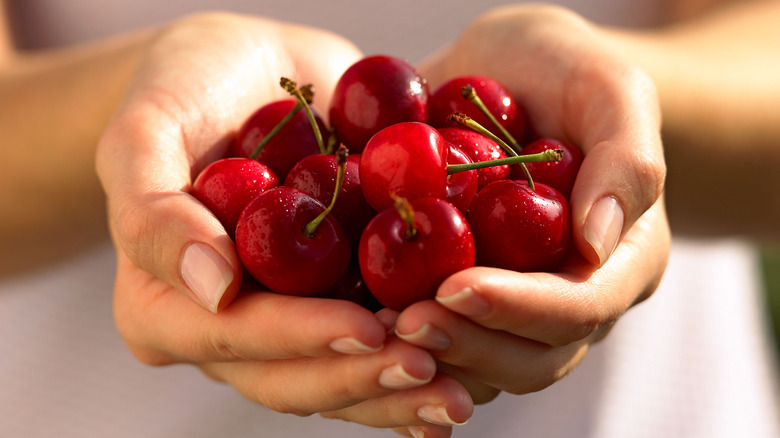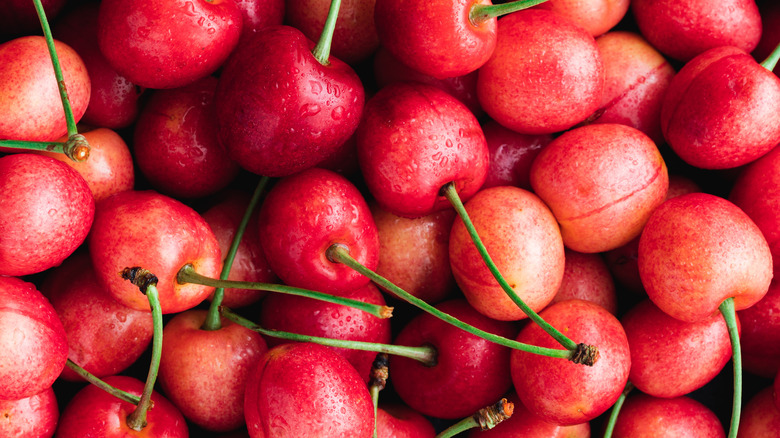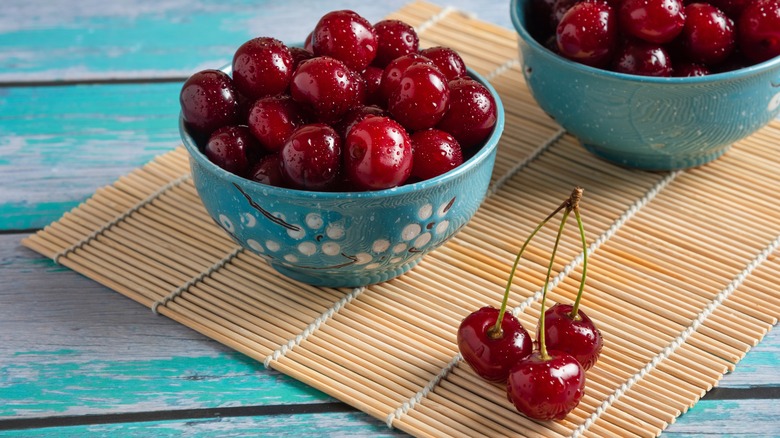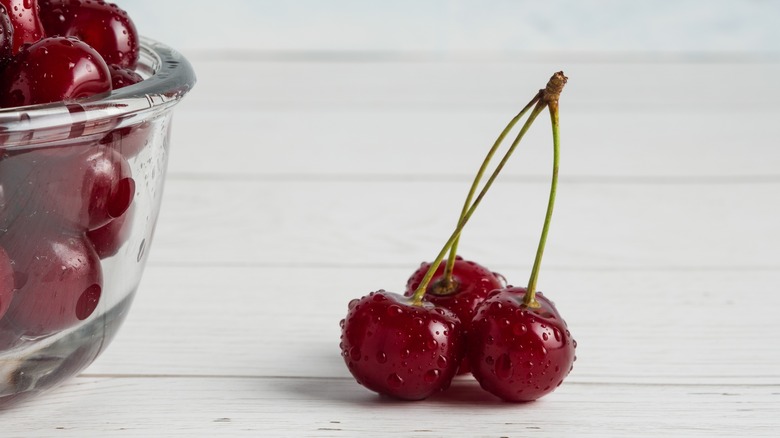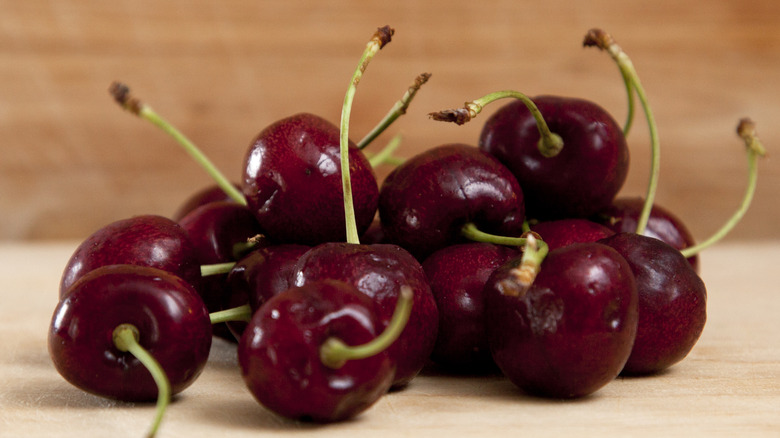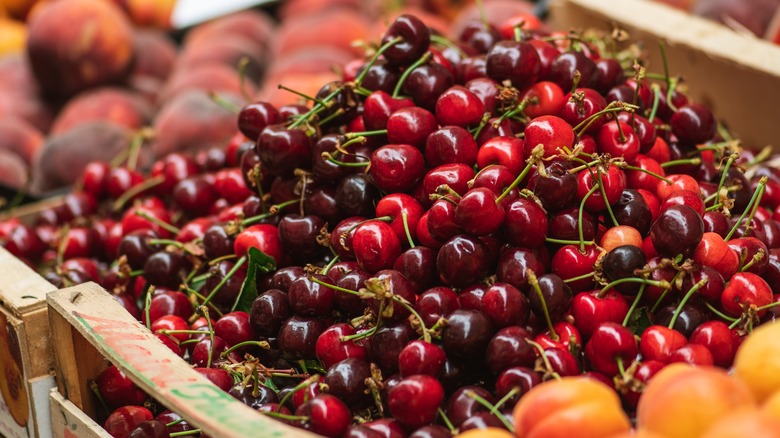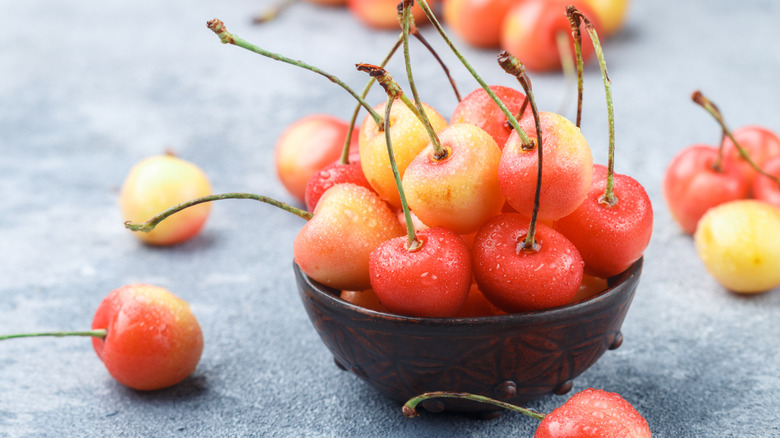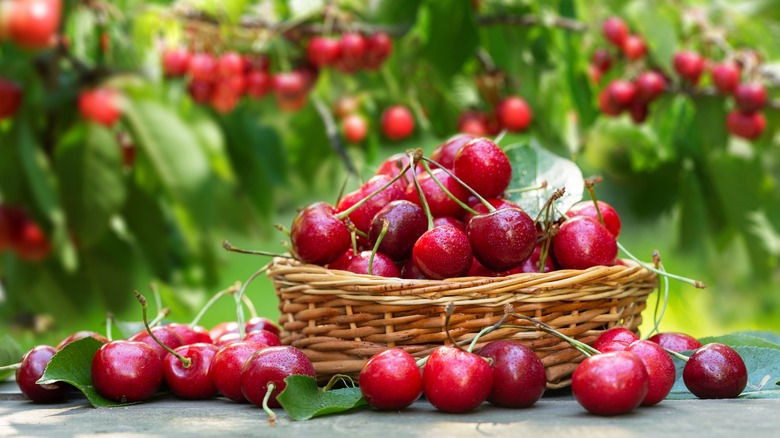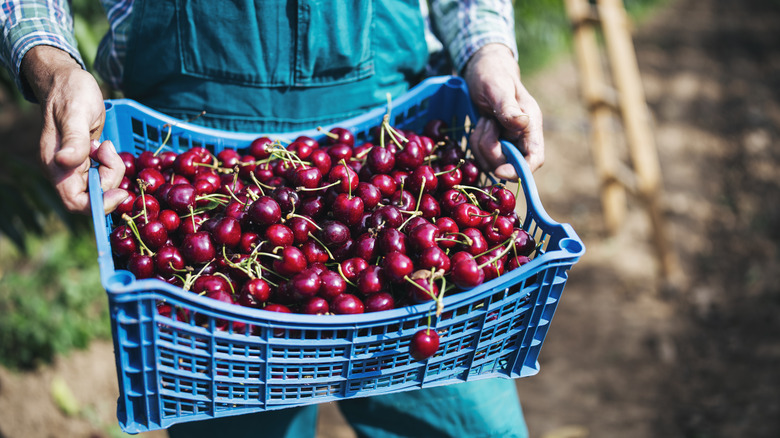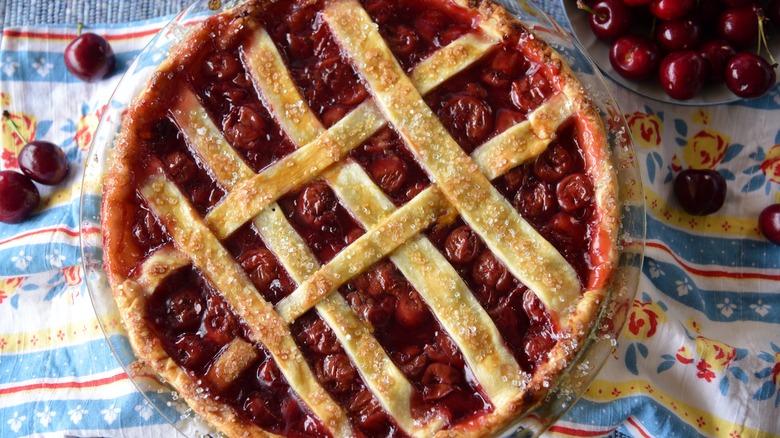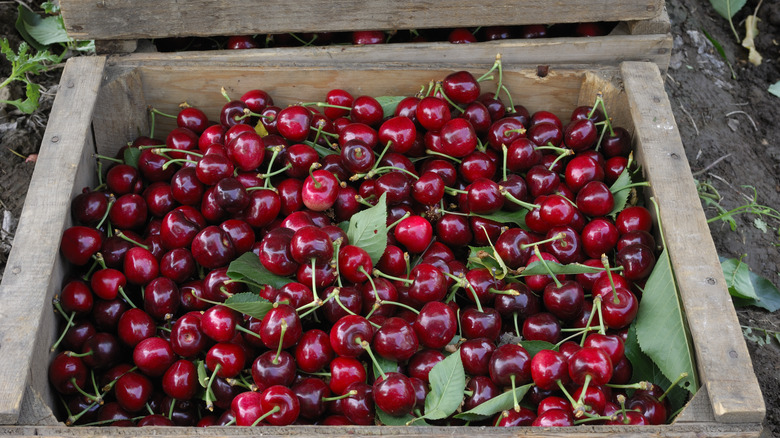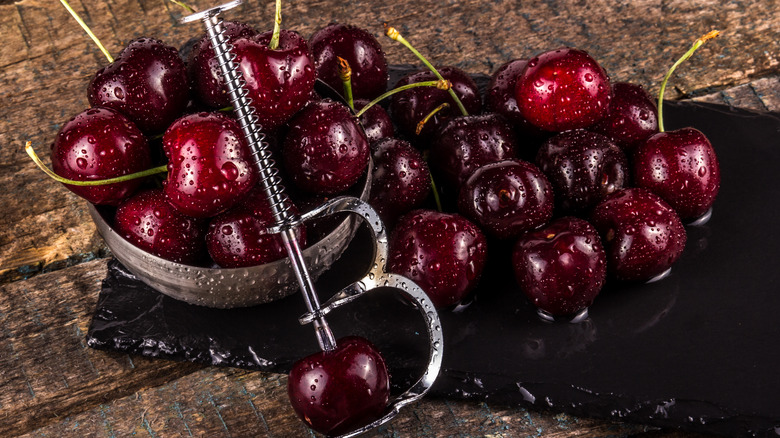What To Know Before Buying Cherries
Cherries are a firm favorite among fruit lovers for good reason. At their best, they're sweet, juicy, and flavorful. However, it's also possible to buy disappointing cherries. They might be overripe and bruised or underripe and tasteless, so it's important to know what you're looking for when buying them. And cherries can be expensive, so getting bad ones is even more of a disappointment.
There are other things you might want to know before buying them, such as when cherry season is, the difference between sweet and tart cherries, and the best cherry varieties to look out for. To get the lowdown on cherries, we spoke to five experts, including chefs and a dietitian. They gave us the tips you need to know to make smart buying decisions when it comes to cherries.
So whether you want to know how to pick the best cherries in the store, how to cook with them once you've brought them home, or how to store them to keep them fresh longer, our experts have you covered. Here's what to know before buying cherries.
Choose cherries with their stems attached
Most of our experts noted that you should choose cherries with their stems attached when you pick them from the store or market. As Andy LaPointe of Traverse Bay Farms told Mashed, you should "make sure the stem is green and firmly attached" because this "indicates a sign of freshness."
The stem remaining in place can also help cherries stay fresh. "They last longer if you buy stemmed varieties," notes Lindsey Chastain, founder of food, farming, and sustainable living blog, The Waddle and Cluck.
So first off, when you're at the store, make sure to pick out the cherries with their stems still attached. Then when you get them home, keep those stems attached until just before you eat or cook with your cherries. This will help them stay fresh much longer. Then you'll be well on your way to enjoying perfectly ripe cherries all the time.
Pay attention to color
If you want to pick cherries that are neither underripe or overripe — and trust us, you do — then you should be paying attention to color. "A deeper color usually indicates ripeness, but avoid cherries that are too dark because they could be overripe," explains Tamara Earl, the owner and chef of vegan restaurant Delectablez.
But the cherry variety will also make a difference to the optimal color. Lindsey Chastain notes that "ripe cherries should be deeply colored, ranging from golden to deep red depending on the variety." So know what color the cherries you're buying should be and choose accordingly. For instance, Rainier cherries are a golden yellow color with some areas of pink or red blush. Andy LaPointe suggests any cherries you choose should be "vibrant in color," which seems like a good place to start.
The correct color is a cherry's way of indicating that it's ready to eat. So this is an especially good way of checking if cherries are ripe when buying them in sealed baskets at supermarkets.
Choose plump, firm cherries
"I recommend looking for cherries that are firm and plump," remarks Tamara Earl. She adds that you should avoid cherries that are wrinkled. Firmness is an indicator that cherries are ripe. When they start to overripe, they can wrinkle, shrivel, or start to look soft, rather than firm.
"Firm, but not hard cherries are best," says Gocha Hawkins of Gocha's Restaurant Group. So although you want them to be plump and firm, cherries that go over firmness into hard territory are likely underripe and might be tasteless. You need to find that sweet spot between too firm and not firm enough.
If you have the opportunity to (usually at farmers markets where the fruit is not in sealed packaging), you can gently squeeze the cherries you're considering buying, to check for the ideal texture and firmness. If you aren't able to touch them, make sure the cherries look plump without any soft or wrinkled parts.
Avoid cherries with blemishes and soft spots
Cherries with visible soft spots, bruises, and blemishes are usually overripe. This means they won't taste as good and might go completely soggy or moldy soon. Tamara Earl recommends that you "totally stay away from cherries with blemishes, soft spots, or wrinkles." Lindsey Chastain backs this up, saying that you should "avoid any with bruises or soft spots."
When you buy cherries loose, it's easier to pick through them and discard any that have flaws. If you're buying them in a punnet, try to get a look at as many as you can and avoid punnets with even a couple of blemished cherries. You've probably heard the saying that one bad apple spoils the bunch. Well, the same is true of cherries — literally. When one cherry is bad, it can spread through the whole batch, causing them to spoil quicker than they would have otherwise. So once you get a container of cherries home, sort through them and remove any bad ones.
It's best to buy cherries in season
Want the most delicious cherries? Buy them in season. "Cherries are typically in season during late spring and summer, usually from May to August," explains Tamara Earl. "My best recommendation and what I always do is buy them in season to ensure they are at their peak flavor and freshness." Gocha Hawkins agrees with this. She says, "As with all fruit, buying in season is best. You not only get the economical value, but more importantly you get the best taste and benefit most from their nutritional and health value."
So when possible, buy cherries in season. We're not saying that you can never buy them out of peak season, but you shouldn't expect the same quality and they're likely to cost you more. That's why it's good to make a point of enjoying cherries in season, while they're at their best. Try heading to your local farmers market to find some of the freshest offerings, as well as varieties you might not find at the store. Plus, you can often taste-test at farmers markets. Hawkins notes that it's "the ultimate way to ensure you're getting what you want."
There's a difference between sweet and tart cherries
Before you buy cherries, you should know that cherries come in two overarching types: sweet and tart. It's important to understand the difference between sweet and tart cherries so you buy the right ones for your desired purpose.
Tamara Earl explains the difference nicely. She says that sweet cherries "are larger and juicier [and] they also have a higher sugar content, making them ideal for snacking or desserts." On the other hand, she notes that tart cherries "are smaller, less sweet, and more acidic ... often used in cooking, baking, or making preserves." Lindsey Chastain goes further by saying that tart cherries "have a higher acidity and tarter flavor that works better for baking."
Generally, tart cherries will be labeled as such. However, if you're not sure which is which, Gocha Hawkins explains some differences to look out for: "Sweet cherries are larger, firmer, and more heart shaped. Tart cherries are smaller and more spherical."
Sweet cherries and tart cherries both have their place, but it's important that you choose the right ones for you. If you're looking to eat cherries fresh, tart cherries aren't going to be the best option. But in many cooking applications, tart cherries have a more intense flavor that works well.
You can choose from many cherry varieties
Now you know there are sweet and tart cherries, but there are actually many more varieties of cherries. In fact, there are more than 1,000 cherry varieties in existence. This might seem like a huge number to choose from, but you'll usually only have the option of a few cherry varieties at a store, so it's not too overwhelming. If you head to a farmers market, you may find more unusual varieties.
"Bing, Rainier, and Brooks are common sweet cherries," Lindsey Chastain notes. "Rainier cherries are my absolute favorite. They are mildly sweet with just a hint of tart, so they work for many different types of recipes. They are also great to just eat!" Bing cherries are also among Tamara Earl's favorites: "Bing cherries are loved for their deep and sweet flavor." As for tart cherries, she likes Montmorency cherries because they "give [a] tartness perfect for pies and jams."
Cherries have a range of health benefits
We spoke to dietitian Ana Reisdorf, MS, RD, co-creator of food blog The Food Trends to find out more about the health benefits of cherries. "Cherries are rich in vitamin C, potassium, and polyphenols (antioxidants)," she says. "These nutrients support immune function, heart health, and help lower inflammation."
That's a great start, but that's not all. "Additionally, their high antioxidant content can help fight oxidative stress and may reduce the risk of chronic diseases," Reisdorf explains. So those are some excellent reasons to incorporate more cherries into your diet, if taste alone wasn't enough.
If you're thinking about cooking with your cherries, you should know that it might impact their nutritional content. "Cooking cherries can impact their nutritional value, decreasing the content of certain vitamins, like vitamin C, due to heat sensitivity," says Reisdorf. "However, cooking may also increase the bioavailability of some other compounds." So it's not as simple as raw equals good, cooked equals bad. You might increase the nutritional availability of some compounds by cooking them. In other words, it's great to eat both cooked and raw cherries.
Organic cherries are great, but don't sweat it if you can't afford them
Should you buy organic cherries or are conventionally grown cherries just fine? "Buying organic cherries can lower your exposure to pesticides and may have higher antioxidant levels," notes Ana Reisdorf. So of course they're great if you can access and afford them. However, that's not where the story ends. Reisdorf adds, "It is always better to eat cherries, even if not organic, rather than not eating them because you can't afford the organic."
The fact of the matter is that organic cherries are almost always more expensive and not in everyone's budget. And not everybody has access to a store that sells organic cherries. So as Reisdorf recommends, you should buy whatever cherries you can get your hands on. Don't let the fact that you can't find or afford organic stop you from buying cherries, because it's better to get the nutritional benefits that cherries offer than to not eat them at all.
There is such a thing as eating too many cherries
Cherries are healthy. You can't eat too many of them, right? Actually, wrong. Everything in moderation is a solid way to approach food. You can, in fact, have too much of a good thing. According to Ana Reisdorf, "eating too many cherries can lead to digestive issues due to their high fiber content." There's also the simple fact that diets should be balanced. If you fill up on cherries, you might not be getting enough of other essential nutrients, such as fat or protein.
Reisdorf warned us with a story about a time when eating cherries ended in trouble. "Last summer my kid decided to eat the whole cherry (including the pits) which landed us in the ER for six hours to monitor him for cyanide poisoning. Excessive consumption of cherry pits (which contain cyanide compounds) can be toxic. Luckily, he was ok!" So there you have it. Don't eat too many cherries and definitely don't eat the pits.
You can make a range of sweet and savory recipes with cherries
You might think of cherries as something that you only eat raw or perhaps baked into a pie, but there are many other ways to cook with cherries. You might be aware of a variety of sweet cherry dessert recipes, but there are also savory ways to enjoy cherries, if that's more your speed.
The experts we spoke to shared some of their favorite ways to use cherries. "I love to make cherry and goat cheese grits," says Gocha Hawkins. "I elevate the classic comfort dish with a blend of creamy, tangy goat cheese and the sweet, tart pop of cherries." Tamara Earl also has a variety of favorite cherry recipes. "Some of my favorite uses for cherries are cherry pie, cherry crisp, and cherry compote ... [they] are classic sweet options," she says. And in terms of savory recipes, she recommends, "using cherries in salads with arugula and balsamic vinaigrette, or pairing them with roasted veggies."
It might sound strange, but you can also make your own pickled cherries. These are great in both sweet and savory applications — on oatmeal or pancakes, with ice cream, or on toast with cheese.
Avoid cherries sold in a wet wooden crate
When you buy cherries at a farmers market, they're often sold in wooden crates or punnets. They're also generally sold by weight. There's something very specific to look out for in these circumstances: Making sure the wooden crate you buy them in is dry.
Andy LaPointe explains why this is something to pay attention to: "Sometimes farm markets or farm stands will put the container into water prior to adding cherries. Then the container containing the cherries will be placed atop a scale. If the container is of wood and was submerged into water, this will add additional weight to the container and cause an increase of price paid since you will be paying for the price of the cherries per pound, plus the weight of the container and the weight of water absorbed into the wooden box."
So avoid being charged extra for your cherries by making sure that any container they're sold in is dry. If someone tries to sell cherries to you in a wet crate, you can insist they're weighed in a bag, without the container. Or simply just head to another stand that isn't trying to overcharge you.
Store your cherries in the fridge and don't wash them before use
You should know how to store your cherries once you get them home so that they stay fresh longer. After all, the last thing you want is your perfectly ripe cherries to go to waste. "One of the best ways to store cherries is to refrigerate without washing them until just before use," says Andy LaPointe. "The reason is that if the cherries are washed prior to storage, additional moisture can promote mold growth."
Gocha Hawkins has an additional suggestion for storing cherries. "To keep fresh, store them in a sealed plastic bag or storage container," she recommends. "Add a paper towel to help absorb moisture." Once you have your cherry storage down, you might find you get a few extra days from them before they start to go bad or become overripe. Luckily the solution is fairly simple. Store them in the fridge, in a sealed container, and don't wash them until right before you eat or cook with them. But how long do cherries last in the fridge? Only around a week, so make sure you get to them fairly quickly.
Pitting cherries is easier with the right tools
If you're cooking with your cherries or adding them to a fruit salad, you're going to have to tackle the arduous task of pitting them. It's one of those kitchen tasks that people often dread and totally avoid if they can. But it doesn't have to be as hard as some folks make it. Pitting cherries with the wrong tools is one of the most common mistakes that people make with cherries. However, if you use the right tools, it isn't too difficult.
"I use a cherry pitter tool for easy removal of the pit," says Tamara Earl. But since not everyone pits cherries often enough to want to buy a dedicated tool, she offers some alternate advice: "You can also carefully slice around the cherry's pit with a paring knife or use a paperclip to push the pit out." And to avoid making a mess while you do it, "make sure to wear an apron or old clothes just in case, because cherry juice can stain."
